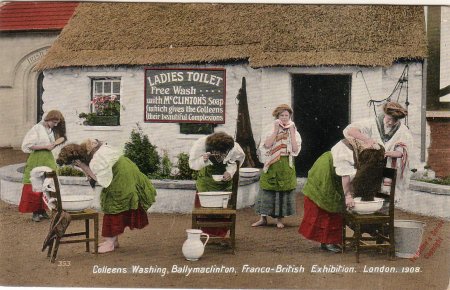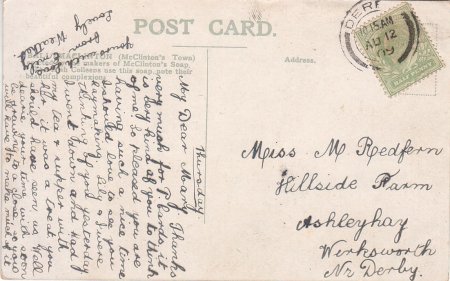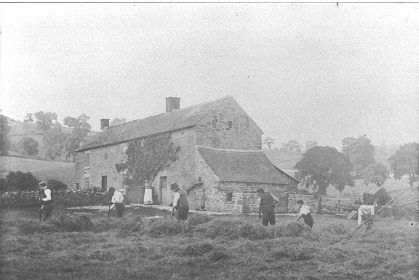The Derby Mercury for 2 July 1890 reports
The HAY HARVEST in DERBYSHIRE
The hay harvest in Derbyshire, writes a correspondent,
has now been commenced in many districts, but during the
past few days the weather has been of such an unsettled
character that further operations have been somewhat
delayed, and the farmers are busy with that already cut.
On Saturday, towards evening, the county in some parts
was visited with a thunderstorm, and the weather on Sunday
was dull and threatening. The crops, speaking
generally, will not be anything like so heavy as last year
- an exeptional season. In the Southern part of the
county some capital crops are promised with settled
weather. The harvest in North Derbyshire will be late
and poor.
|
The Derby Mercury for 6 August 1890 reports
HARVEST REPORTS
RIPLEY DISTRICT
The season has been of a very uncertain character-
often wet and generally stormy. The absence of sunshine
has been a marked characteristic of July certainly. Very
little hay has been got in yet, although the crops are generally
good in this district, and indeed some of the farmers
have so much of last year's hay left that they can afford to
let the present season's hay wait longer. The wheat and
seed crops in this part promise better than the hay; clover
and dilla are looking well. The hay harvest is behind, and
the corn, which is looking well, will also be late this season,
except the voming month (August) is hot. The agricultural
look out for 1890 is really promising and encouraging
at this time. Some wheat and oats belonging to the
Butterley Company in the immediate locality of Ripley look
really magnificent. Oats and barley cannot be said to be
backward. The potato crop will yield well, and no signs
of disease are yet manifest. As to the root crops we must
speak favourably of them, mangolds, turnips and swedes
looking well. No Hessian fly has made its appearance in
this locality, and no pest of any other kind has been
observed sufficiently to inflict any serious damage. The
hay and corn harvests for 1890 promise well.
|
The Derby Mercury for 6 August 1890 reports
ASHBORNE
HARVEST PROSPECTS - The hay crops in this neighbourhood
have left very little to be desired by farmers.
The yield has been good, but hardly up to last year's
heavy crop; but what deficiency exists in quantity
has been made up in the excellent quality of this year's
hay crops. The hay harvest, by reason of the unsettled
weather, will be quite a month later than usual,
but already a large proportion of the hay in this
district has been stacked in prime. This neighbourhood
is essentially a grazing district rather than
a corn-growing district, consequently very little
arable land is to be found. The reports of the condition
of the corn are very favourable, farmers speaking
of it as looking "first class", and bidding fair to be a
very good crop both in ear and straw.. It is satisfactory
to note that no blight has been observed. Green
crops are not extensively grown here, but what few
there are they have done very well. The potato yield
is very favourable, and no disease has as yet been
noticed. The fruit yield is a good average one.
Farmers will not be short of keep for the coming
winter. The difficulty appears to be on the score of
getting stock whilst high prices are maintained.
|
These are just a few typical references, which suggest that
the season varied quite a bit according to the weather.
I did not pick up anything useful for 1900, which is as
far as the 19thC newspaper database goes for the Derby Mercury.
A much later source, “Farming in the Midlands” by Stephen
Williams (1967) says that haymaking proceeds in June & July,
and if it rains the work is suspended until the top of the
swath is dry. By then of course the process was mechanised.
Very long, detailed and lyrical descriptions of the hay
harvest are given by Alison Uttley of Cromford, harking back
to the 1880s and 1890s when Irish labourers came over to get
the hay in. (They ceased coming over in about 1914). In
particular see the chapters “Mowing-time” and “Harvest”
in “Carts & Candlesticks”, 1941, and “The Stack-yards” in
“Cuckoo in June” (1964). The latter goes into great detail
about the preparation of the stacks, and how a third was
prepared for an unusually good harvest. Frustratingly she
is very vague as to actual months, telling us only that
the stackyards were prepared in March or April when the
last of the old hay had been used.
I have not been able to find any references to the actual farm
you mention, either in our indexes or in the 19thC newspaper database.
Overall it sounds as though 12th August would not have been unusual,
depending on the weather. I hope they were not too near the grouse moors!
Yours sincerely
Sue Peach
Local Studies Librarian




 ----
----